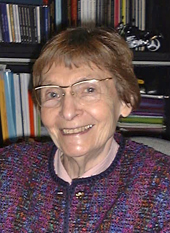

Alberte Pullman

Born August 26, 1920 in Nantes, France.
Honorary Director of the Theoretical Biochemistry Department, Institut de Biologie Physico-Chimique, Paris, France. Directeur de Recherche Emerite at CNRS.
Doctor Honoris Causa of the Universities of Liege (1976), Uppsala (1977), Torino (1985). Medal Sir Yagdish Bose of the Academy of Medical Sciences of India (1977); Cori Award of the Roswell Park Memorial Institute, Buffalo, USA (1984); Prix Essec de la Ligue Nationale contre le Cancer (1956); Prizes of the French Academy of Sciences: Bonneau, (1958); de Saulces de Freycinet (1963); High Atomic Energy Commission (1988). President of the International Academy of Quantum Molecular Sciences (1985-1991). French Legion of Honor (Chevalier, (1981)). National Order of Merit (Commander, (1989)).
Author of:
Important Contributions:
- Doctorate Thesis on "The relation between the electronic structure and the carcinogenic properties of aromatic hydrocarbons", Paris (1946): definition of the K-region. Definition and role of the L and M regions; correlations with carcinogenic properties, summarized in 1956 book.
- Research on problems of Theoretical Organic Chemistry by the early methods of molecular orbitals (1947-1955) summarized in 1952 book.
- First theoretical calculations on biomolecules : the components of Nucleic Acids.
- Extensions to more complex systems: development of the "supermolecule" technique for hydrogen-bonding, molecular hydration, cation binding; developments of techniques for calculation and representation of molecular electrostatic potentials and fields for large macromolecules. First applications to DNA, RNA, proteins, ionophores etc.
- Theoretical studies of the transfer of ions through biological membranes (Gramicidin A; modelisation of the acetylcholine receptor channel); of the structure of lipid layers and their interactions with inserted molecules.
- Theoretical research on cation p interactions and their components.